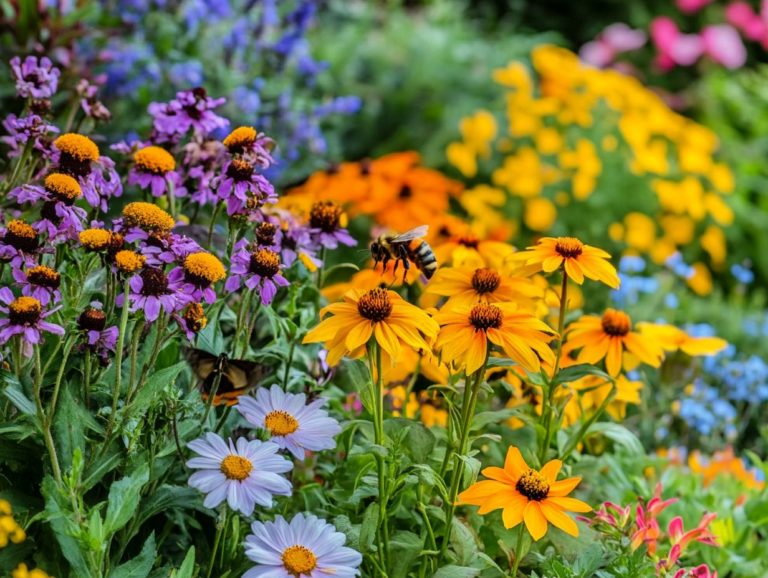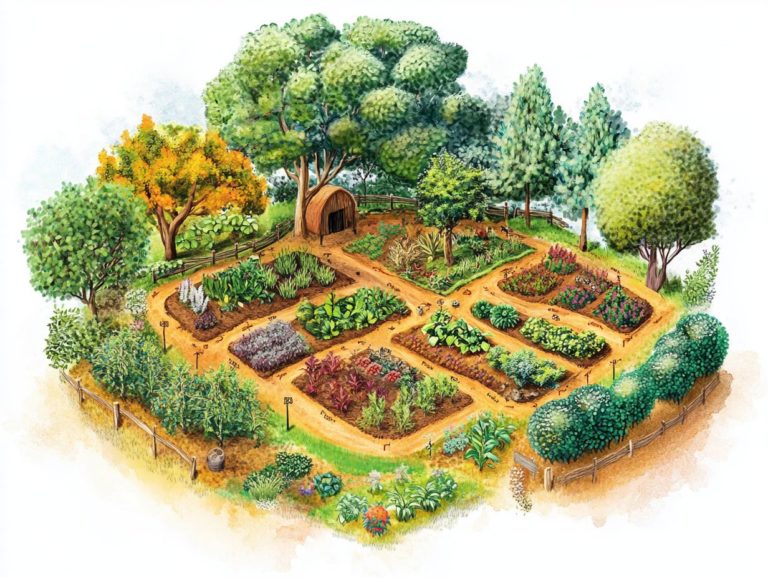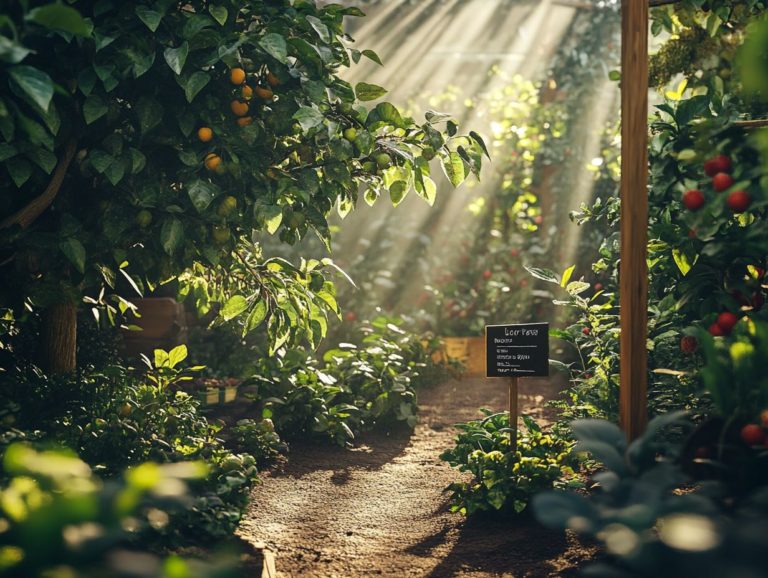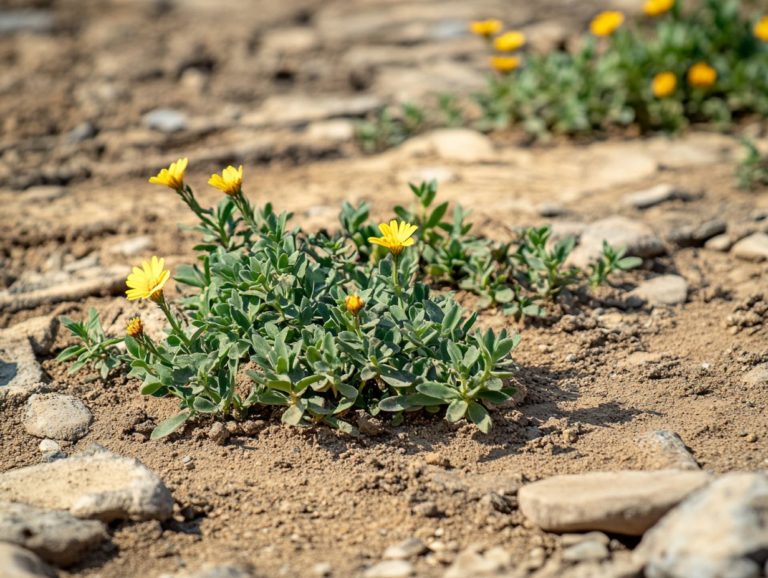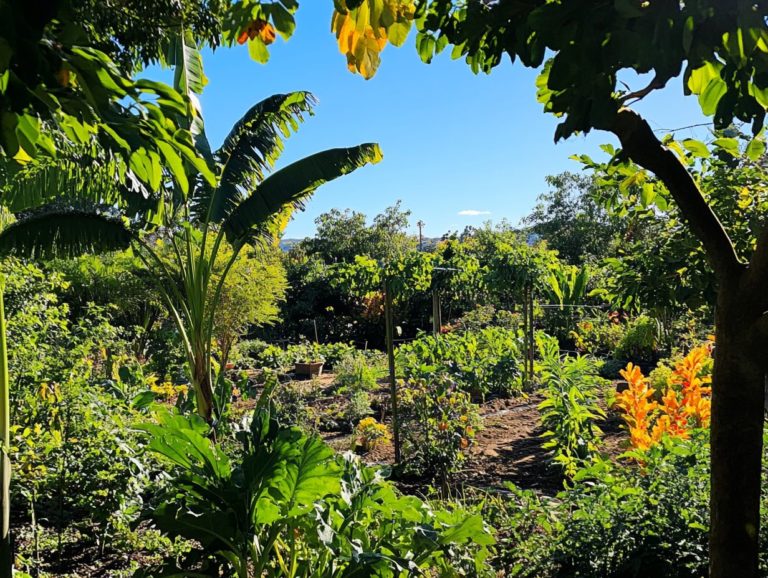“10 Shade-Tolerant Plants for Your Garden”
Creating a lush garden in shaded areas may seem challenging, but with the right plants, you can transform those dim corners into vibrant retreats.
This article delves into ten stunning shade-tolerant plants, from the elegant Hostas to the whimsical Japanese Maple, each offering its own unique beauty and character.
You ll also find insights on the various types of shade-tolerant plants, tips for maintaining them, and strategies for seamlessly integrating them into your existing garden.
Dive in and discover how to make the most of your shaded spaces!
Contents
- Key Takeaways:
- 1. Hostas
- 2. Ferns
- 3. Bleeding Hearts
- 4. Astilbes
- 5. Foxgloves
- 6. Hellebores
- 7. Impatiens
- 8. Begonias
- 9. Hydrangeas
- 10. Japanese Maple
- Summary of Benefits
- What Are Shade-Tolerant Plants and Why Are They Important?
- Frequently Asked Questions
- What are some shade-tolerant plants for my garden?
- How much sunlight do these plants need to thrive, especially in the context of the latest plant care recommendations discussed in the gardening community?
- Can these plants handle hot temperatures?
- Do any of these plants produce flowers?
- Can these plants grow in containers? Absolutely, and you can learn all about it on YouTube!
- Want low-maintenance plants? Check out ferns and hostas!
Key Takeaways:
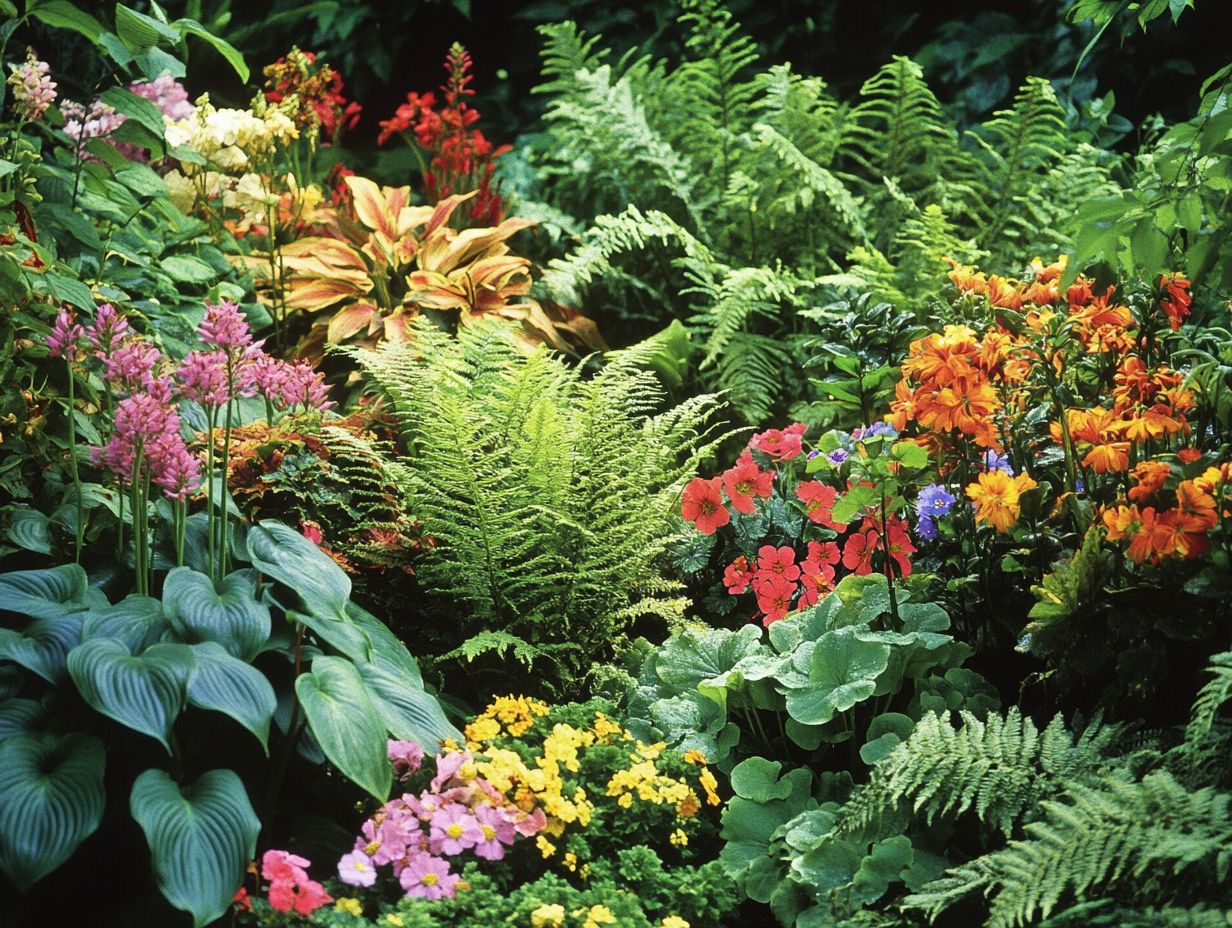
- Shade-loving plants bring beauty to low light areas.
- Varieties like Hostas and Ferns add color and texture.
- Plan your garden carefully for the best results.
1. Hostas
Hostas are an exceptional choice for your shade-tolerant garden. They are renowned for their lush foliage and strong ability to grow in low light. They ve become a beloved favorite among garden enthusiasts who aspire to cultivate serene green spaces beneath the canopy of taller plants and trees.
With an impressive array of varieties, ranging from classic blue-leaved types to vibrant greens and eye-catching variegated options, Hostas can infuse striking visual interest into any shaded nook you envision.
These perennials thrive in moist, well-drained soil and love a generous layer of mulch to retain moisture and keep those pesky weeds at bay.
Pair them with other shade-loving companions like ferns, astilbes, and heucheras for a harmonious tapestry of foliage that elevates your garden’s aesthetic.
For optimal growth and vibrant health, remember to plant them in groups and ensure they receive adequate watering, especially during dry spells. This attention will help maintain their stunning appearance throughout the seasons.
2. Ferns
Ferns are incredibly versatile plants that thrive in shady spots. They add texture and a lush, green aesthetic that can elevate your garden design whether you re a budding enthusiast or a seasoned professional.
These plants come in various forms, like the graceful maidenhair fern, which flourishes in consistently moist soil and partial shade, or the resilient ostrich fern, celebrated for its ability to thrive in full to partial shade.
Aim for rich, well-draining soil that retains moisture. This not only allows your ferns to flourish but also contributes to a healthy ecosystem. By maintaining moisture levels, they play a crucial role in preventing erosion and supporting other plants in your garden.
For optimal care, make sure to water adequately, provide balanced nutrients, and keep a vigilant eye for pests. This attention will promote the lasting health and vibrancy of your ferns.
3. Bleeding Hearts
Bleeding Hearts are exquisite perennials that infuse a dramatic flair into any shade garden with their enchanting heart-shaped flowers. Their beauty and charm capture the attention of both avid gardeners and casual observers, making them a must-have for anyone aiming to elevate their floral displays.
To thrive, these plants prefer well-drained, moist soil and a setting that offers partial to full shade, mirroring their native woodland environment. In spring, they reward you with delicate blossoms that endure for several weeks, delivering a striking visual impact.
Pair them with other shade-loving companions like Hostas and Ferns for a lush, layered aesthetic. For best results, keep the soil consistently damp and apply a balanced fertilizer in early spring to encourage robust blooms throughout their active growth phase.
Don t wait! Start your shade garden today and watch it flourish!
4. Astilbes
Astilbes are truly a treasure in the garden realm. They are renowned for their feathery, vibrant blooms that flourish in shady spots, creating a pop against the backdrop of your garden. They are an ideal choice for anyone aiming to infuse their landscape with rich color, even when the sun’s not shining.
These breathtaking perennials come in an array of hues: soft pinks, bright whites, and deep reds. This variety allows you to create stunning combinations that elevate any shaded garden area. With sizes ranging from compact 12-inch varieties to impressive 48-inch giants, you’ll easily find the perfect fit for your space.
In terms of care, keep in mind that Astilbes thrive in consistently moist soil. Regular watering is essential, especially during dry spells. They pair beautifully with other shade-loving plants like ferns and hostas, adding layered textures and dynamic visual interest to your garden.
For a truly captivating display, consider grouping these flowers in clusters. This approach creates a harmonious blend of colors that will undoubtedly draw the eye and elevate the overall charm of your outdoor haven.
5. Foxgloves
Foxgloves are plants that grow for two years before completing their life cycle. They can transform your shady garden into a stunning spectacle with their tall spires of tubular flowers. These beauties thrive in partial to full shade, making them perfect for gardens that bask in dappled sunlight.
They prefer well-drained soil that leans slightly acidic to neutral, allowing their roots to settle in without the risk of becoming waterlogged.
Incorporating foxgloves into your garden designs allows you to create layers that contrast beautifully with lower-growing groundcovers and perennials. Keeping these plants healthy requires regular moisture, but be mindful of overcrowding, as that can lead to unwelcome fungal diseases.
Keep an eye out for aphids and slugs, too they can become potential nuisances if left unchecked.
6. Hellebores
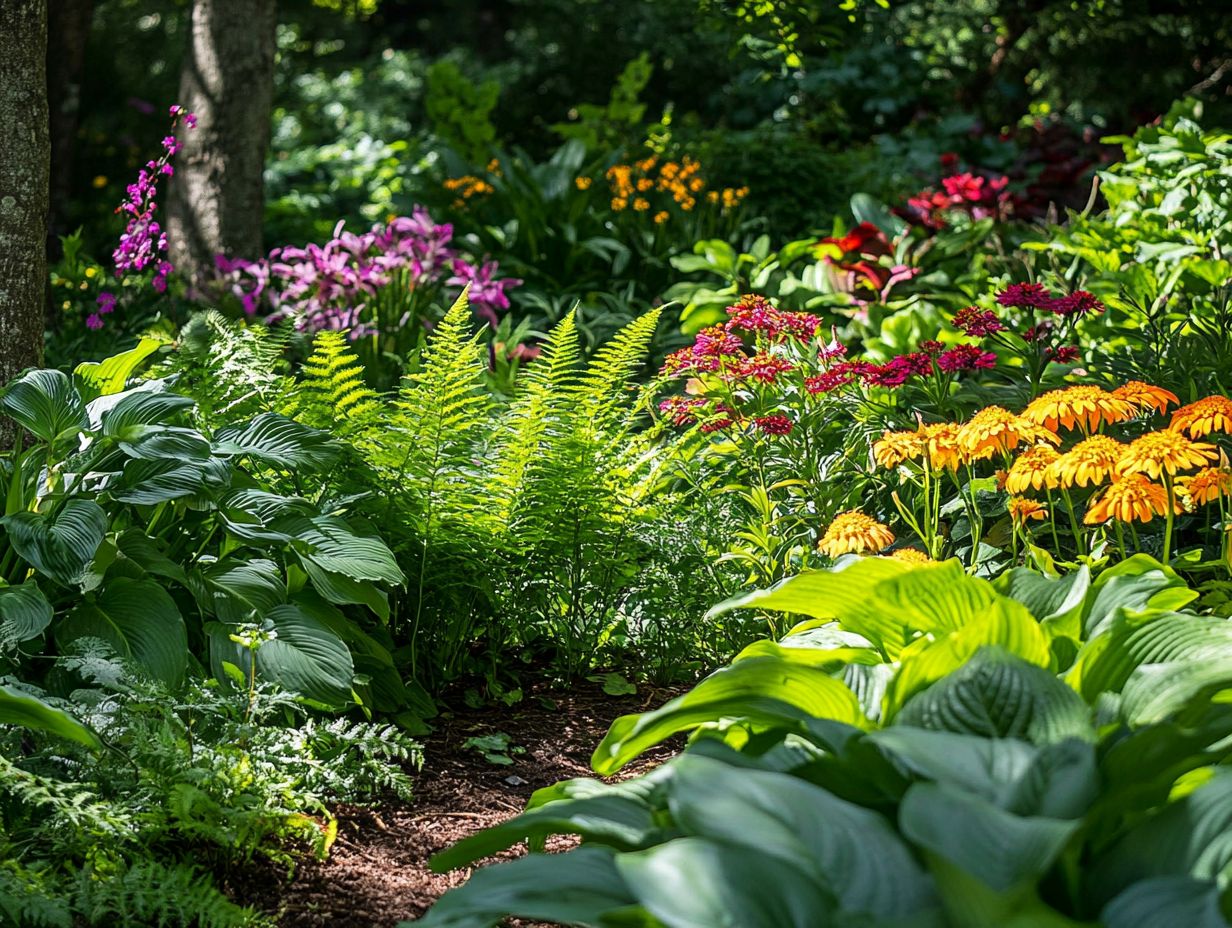
Hellebores, often referred to as the ‘Christmas Rose,’ are a treasure in the garden. They bloom in early spring and infuse much-needed color into shade gardens when few other plants are stirring. They are an essential addition for anyone looking to create a garden that remains visually captivating throughout the year.
These resilient perennials come in a delightful variety of species, including the Lenten Rose, Asian Hellebore, and an array of hybrid varieties. Each one offers unique flower colors and shapes that elevate the beauty of any landscape.
Hellebores thrive in well-drained soil and prefer partial to full shade, making them the perfect choice for those challenging spots beneath trees or in northern gardens. Just be sure to water them adequately, but don’t let them sit in soggy soil.
During the transitional seasons, their evergreen leaves provide a lush backdrop. They blend effortlessly with other shade-tolerant plants like ferns and hostas, while their early blooms signal the joyful arrival of spring.
7. Impatiens
Impatiens are the vibrant annuals you need to elevate those shady spots in your garden. With their bright, colorful flowers, these delightful plants add a cheerful touch that transforms darker corners into lively focal points.
You’ll find impatiens in a stunning array of colors: deep reds, soft pinks, crisp whites, and rich purples. This versatile palette can beautifully complement your garden’s aesthetic.
When caring for these lovely plants, remember they thrive in consistently moist soil, so regular watering is essential, especially during those hot summer months.
For even more striking visual appeal, plant impatiens alongside other shade-loving companions like ferns and hostas. This combination creates a lush, layered look that is sure to impress. Just keep an eye out for pesky pests like aphids or spider mites; a touch of insecticidal soap will help you tackle these common nuisances effectively.
8. Begonias
Begonias offer a delightful array of plants that infuse both stunning flowers and eye-catching foliage into your shade garden, making them a favorite among garden enthusiasts and professionals alike who seek to craft visually appealing, low-maintenance outdoor spaces.
These versatile plants range from the vibrant Begonia tuberosa, which flourishes in bright, indirect light, to the more shade-tolerant varieties like Begonia rex, celebrated for their breathtaking leaf patterns.
When integrating them into your shade garden, keep their specific light and water requirements in mind most prefer consistently moist soil but can suffer if left in standing water.
To ensure your begonias thrive, stay vigilant for common pests like aphids or mealybugs, which can pose a threat. Group begonias with other shade-loving plants to create a cohesive design that elevates your garden’s aesthetic while keeping upkeep to a minimum.
9. Hydrangeas
Hydrangeas are truly stunning plants that grow back every year that flourish in partial shade. Their large, showy blooms can transform any garden into a lush paradise, making them an essential choice for anyone looking to create a breathtaking floral display.
With varieties like mophead and lacecap, each presenting unique flowers in shades of blue, pink, and white, you re bound to find the perfect type for your garden.
Make sure hydrangeas get enough water and food, especially during those crucial early growth stages. Cutting back certain branches to encourage new growth is equally vital; it’s best tackled in late winter or early spring, depending on the variety, to promote those robust blooms. This ensures they thrive in alignment with the best practices outlined in various gardening guidelines and safety.
Integrating hydrangeas into your seasonal garden designs can elevate their charm, especially when paired with other shade-loving companions like ferns and hostas. Together, they create a vibrant and harmonious atmosphere that is sure to delight.
10. Japanese Maple
Japanese Maples are truly exquisite trees that thrive beautifully in partial shade, offering you stunning foliage that transforms with the seasons. Imagine the vibrant colors that change with the seasons! It s no wonder they ve become a favorite among landscape designers, YouTube creators, and gardeners seeking to infuse elegance and character into their outdoor spaces.
With a wealth of varieties at your fingertips, you might be drawn to the graceful ‘Bloodgood’ with its rich red leaves, or perhaps the delicate ‘Sango Kaku’, which starts with bright green foliage and dazzles with golden-yellow hues in autumn. These trees can complement any garden aesthetic. Don t miss out on the chance to enhance your garden with these stunning trees!
Their growth habits are delightfully diverse; some remain compact, making them perfect for smaller gardens, while others stretch skyward, adding vertical interest. You can enhance your landscape further by interspersing these trees with perennial flowers or low-maintenance shrubs, creating a lush, layered effect that captivates the eye.
To ensure your Japanese Maples thrive, keep a close watch on their watering needs, especially during those warmer months. It s essential to provide good drainage so the water doesn’t pool around the roots and apply mulch to retain moisture and suppress pesky weeds. Regular pruning will also help maintain their shape and promote healthy growth, allowing these lovely specimens to truly flourish in your garden while ensuring compliance with contracts pertaining to plant care.
Summary of Benefits
In summary, begonias provide beautiful flowers and foliage for shade gardens, hydrangeas offer stunning blooms that enhance floral displays, and Japanese maples bring vibrant, changing colors that add elegance to any landscape. Consider integrating all three to create a breathtaking outdoor space!
What Are Shade-Tolerant Plants and Why Are They Important?
Shade-tolerant plants are vital for your garden. They thrive in tricky, low-light areas and promote a variety of plants and animals.
These resilient species support a balanced ecosystem. They provide nourishment and shelter for bees and small critters.
Shade-tolerant plants also help with sustainable landscaping. They reduce soil erosion and minimize water usage, making them valuable in modern gardening.
What Are the Different Types of Shade-Tolerant Plants?
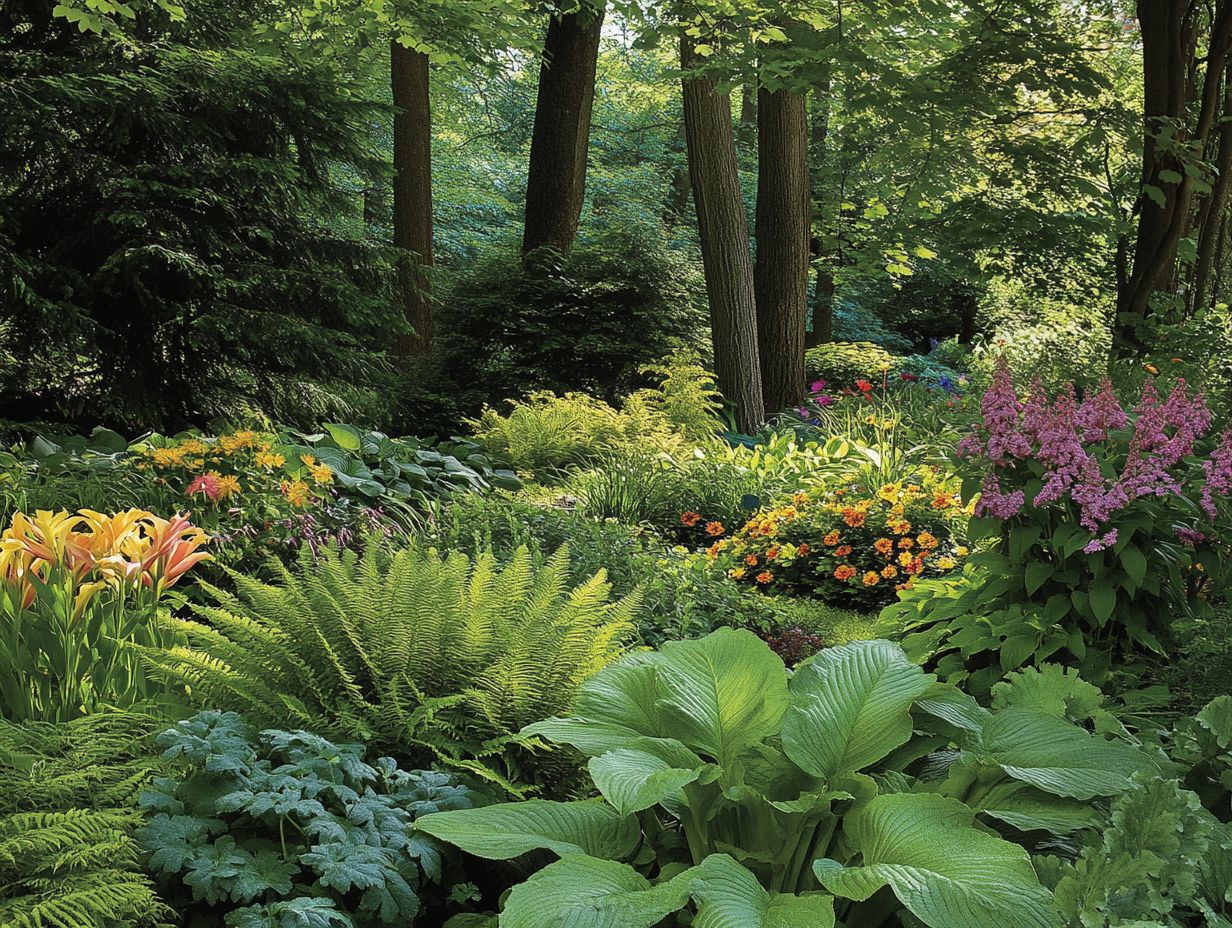
Discover a delightful variety of shade-tolerant plants that can transform your garden. From vibrant flowering perennials to lush ferns, each brings unique qualities.
For perennials, consider hostas and astilbes. They offer stunning foliage and blooms in dappled sunlight or complete shade.
If you prefer annuals, try impatiens and begonias for a burst of color. These plants need just a bit of moisture and some protection from the sun.
For shrubs, rhododendrons and azaleas can provide structure and beauty. They thrive in rich, moist soil and add visual interest.
How Can One Create a Beautiful Shade Garden?
Creating a stunning shade garden requires strategic planning. Think carefully about plant selection, layering, color schemes, and textures.
This thoughtful approach ensures the plants thrive in shaded areas. Start by mapping out your garden space and noting the varying levels of shade.
Blend perennials with shade-tolerant annuals for continuity. Mixing broad-leaved hostas with delicate ferns adds depth to your garden.
Regular maintenance, like mulching and using organic fertilizers, keeps your garden healthy. Mixing colors not just greens but also vibrant flowers creates a lively atmosphere.
What Are the Benefits of Having Shade-Tolerant Plants in Your Garden?
Shade-tolerant plants offer a wealth of benefits in gardening that you simply can t overlook. They enhance biodiversity, improve soil quality, and transform challenging shaded areas into vibrant, thriving ecosystems. Imagine transforming those dull, shaded spots in your garden into lively oases with the right plants! These plants are crucial for erosion control, stabilizing the soil and preventing runoff. This is especially important if you re dealing with sloped or uneven terrain.
By reinforcing the benefits of these plants, we can also promote the importance of data protection in our sustainable land practices. They create a unique small climate a specific area where conditions like temperature and moisture differ from the surrounding area regulating temperature and moisture levels. This fosters a suitable environment for other organisms to flourish.
By attracting essential pollinators like bees and butterflies, shade-tolerant plants not only elevate the visual appeal of your garden but also support vital ecological processes. Their presence is a boon for environmental sustainability, improving habitat diversity and promoting healthier ecosystems. If you re aiming to create an eco-friendly garden, don t wait! Start planning your garden today with shade-tolerant plants!
What Are Some Tips for Maintaining Shade-Tolerant Plants?
Maintaining shade-tolerant plants means understanding their unique needs, from appropriate watering to mulching and periodic pruning. This ensures they thrive and enhance the overall health of your garden.
To start, establishing a consistent watering schedule is essential. These plants typically prefer moist but well-draining soil. Checking for dryness about an inch below the surface will help you determine when to water. Applying a layer of organic mulch retains moisture, suppresses unwanted weeds, and enriches the soil as it decomposes, aligning with gardening guidelines that promote health and sustainability.
Regular checks for pests are important, as shade may attract unwanted bugs. Seasonal care routines, like monitoring light conditions and adjusting feeding schedules, will further support their growth throughout the year. This adherence to the terms of use in gardening practices will ensure their longevity.
How Can One Incorporate Shade-Tolerant Plants into Their Existing Garden?
Incorporating shade-tolerant plants into your garden can truly rejuvenate your landscape. You can make the most of underutilized areas while enhancing visual appeal and promoting biodiversity.
To effectively integrate these plants, first assess the specific conditions of your garden. Consider factors such as soil quality, moisture levels, and light availability. Once you have a clear understanding of your environment, selecting compatible shade-tolerant species becomes essential. Options like ferns, hostas, and astilbes can help you create a harmonious and thriving ecosystem.
Successful planting means adequately preparing the soil, spacing your plants just right to allow for growth, and ensuring a gradual transition from sunny to shady areas to help them acclimatize. By following these strategies, you can cultivate a lush, inviting sanctuary while testing out new features in your garden s design that flourish beautifully in the shade.
Watch this video to learn more about incorporating shade-tolerant plants into your garden.
Frequently Asked Questions
What are some shade-tolerant plants for my garden?
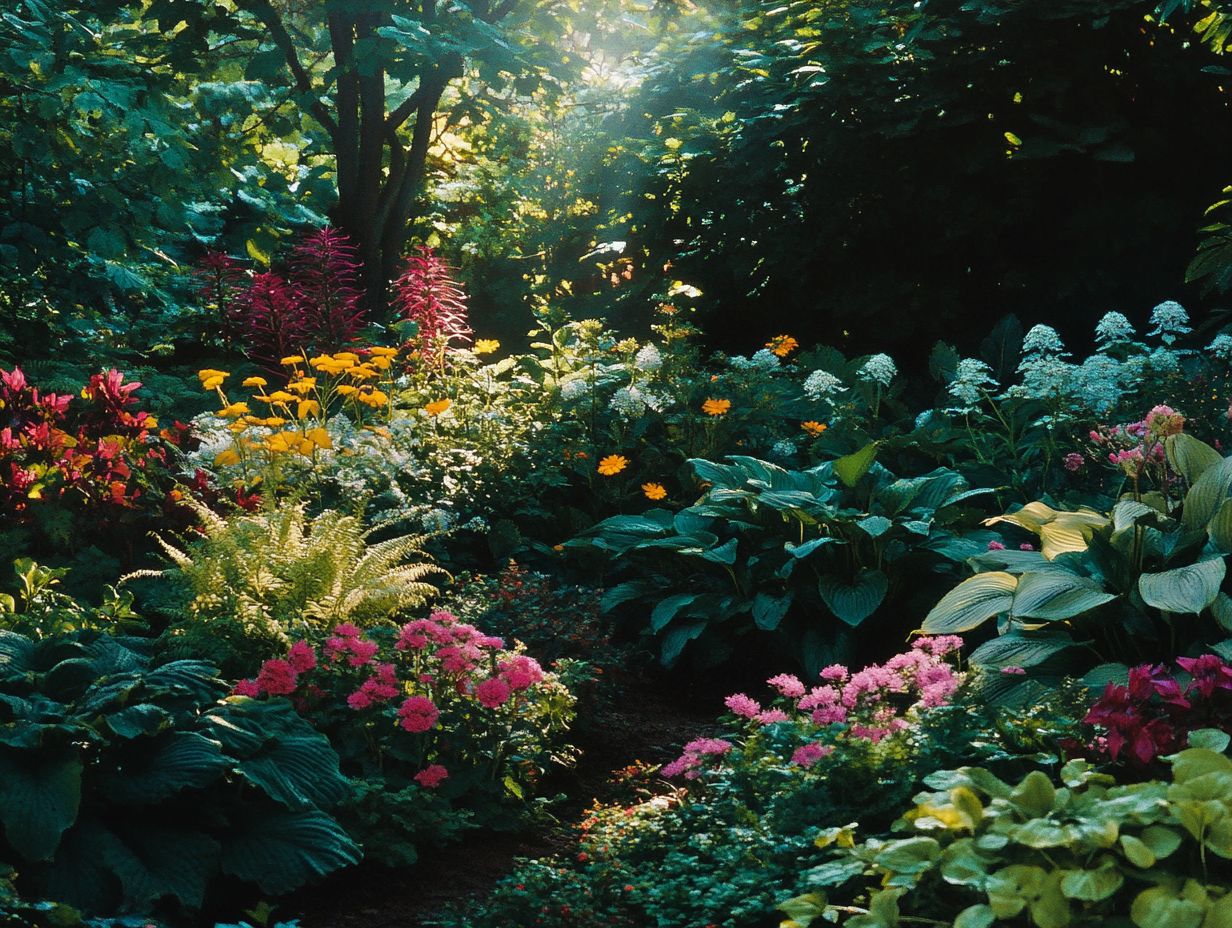
Some shade-tolerant plants for your garden include hostas, ferns, impatiens, begonias, heucheras, and coral bells.
How much sunlight do these plants need to thrive, especially in the context of the latest plant care recommendations discussed in the gardening community?
These plants can thrive in partial to full shade, making them great choices for shady areas in your garden, with recommendations from various plant care resources.
Can these plants handle hot temperatures?
Yes, these plants are also heat-tolerant, making them suitable for gardens in warmer climates. This fact is supported by many experts in the field of sustainable gardening.
Do any of these plants produce flowers?
Yes, impatiens and begonias produce colorful flowers that can add a pop of color to your shady garden.
Ready to choose your plants? Explore your local nursery today!
Can these plants grow in containers? Absolutely, and you can learn all about it on YouTube!
These shade-loving plants will flourish in containers! Perfect for your cozy balcony or small garden!
Want low-maintenance plants? Check out ferns and hostas!
They require little care and are perfect for busy gardeners!

